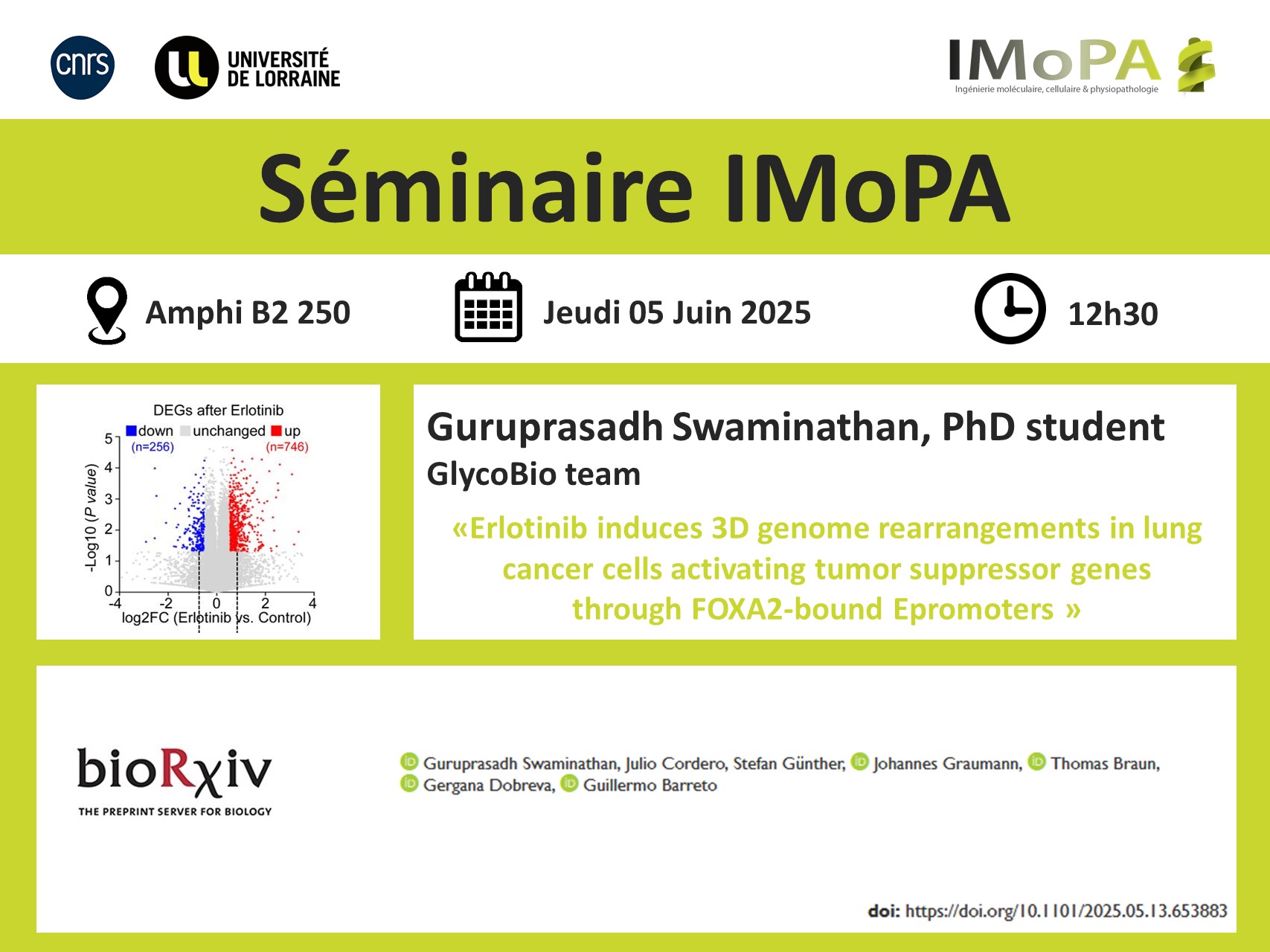IMoPA
Ingénierie Moléculaire, Cellulaire et Physiopathologie
The Unité Mixte de Recherche 7365 Ingénierie Moléculaire, Cellulaire et Physiopathologie (IMoPA) is situated on the Brabois-Santé campus on the outskirts of Nancy.
It operates under the joint supervision of the Université de Lorraine (UL) and the CNRS, to which it is affiliated with the CNRS Biology and CNRS Engineering Institutes. The scientific endeavors of the unit undergo assessment by the CNRS Comité National 28. Researchers undergo recruitment and evaluation by the National Committees (CoNRS) 28, 20, 16, and 26. Additionally, the unit includes three researchers from INSERM.
Our news

Guruprasadh SWAMINATHAN’s pHD defense

Ghita SEKKAT’s PhD defense

IMoPA Seminar
About us
The research and teaching activities of IMoPA’s scholars fall within four disciplinary panels of the Life and Environmental Sciences:
- SVE 3 Living Molecules, Integrative Biology (spanning from genes to genomes to systems), Cell and Developmental Biology for Animal Science.
- SVE 7 Prevention, Diagnosis, and Treatment of Human Diseases.
- SVE 4 Immunity, Infection, and Immunotherapy.
- SVE 5 Neuroscience and Nervous System Disorders.
- SVE 6 Human Physiology and Pathophysiology, Aging.
Hosted within the Biopôle building, UMR IMoPA serves as a hub for a diverse range of expertise, providing valuable resources for the various laboratories within the Université de Lorraine’s Biology Medicine Health (BMS) scientific cluster. According to the 2024-28 contract, the unit is structured into eight research teams. Specifically, neuroscience research takes place in the Pavillon Krug at Nancy’s Hôpital Central.
The Director’s message
The research themes addressed by the eight teams encompass a broad spectrum of expertise, allowing for investigations at molecular, structural, cellular, or integrated levels. These themes are complemented by:
– Multidisciplinary translational research in cell therapy, regenerative medicine, and chronic inflammatory diseases. This research spans from the production of clinical-grade stem or immune cells for antiviral or anti-transplant purposes to the design of substitute biomaterials for osteo-articular applications. The process includes their characterization using imaging techniques, along with the exploration of pathophysiological factors connecting inflammatory joint and digestive diseases.
– Research focused on unraveling the mechanisms of healthy and pathological brain functions related to human cognition. This research primarily relies on multi-modal and multi-scale studies of clinical populations, with a particular emphasis on drug-resistant epileptic patients.

History and Trajectory of the IMoPA Unit
The IMoPA unit (formerly known as Ingénierie Moléculaire et Physiopathologie Articulaire, UMR 7365, CNRS–Université de Lorraine) was established in 2009 through the merger of two complementary laboratories: the PPIA laboratory (UMR 7561) at the Faculty of Medicine and the AREMS laboratory (UMR 7214) at the Faculty of Science and Technology.
Since its establishment, the unit has grown steadily. In 2013, IMoPA was formed with five research teams and a primary affiliation with the CNRS’s Institut des Sciences de l’Ingénierie et des Systèmes (INSIS). By 2018, it had expanded to six teams, and by 2024, it will have evolved into Ingénierie Moléculaire, Cellulaire et Physiopathologie, incorporating the joint expertise of the CNRS’s Engineering and Biology departments and expanding to eight research teams.
The unit also benefits from structural support via shared infrastructures, initially from the FR3209 Molecular, Cellular and Therapeutic Bioengineering Research Federation (BMCT) and then from the 2008/US40 Joint Research/Support Unit (UMS/UAR). This has now evolved into the Shared Platform Service of the Biology, Medicine and Health cluster (SMP-BMS).
At the same time, IMoPA has been part of the region’s institutional evolution. Initially attached to Henri Poincaré University, it was then integrated into the University of Lorraine, and is now positioned within the Biology-Medicine-Health (BMS) Scientific Cluster on the Brabois Health Campus.






